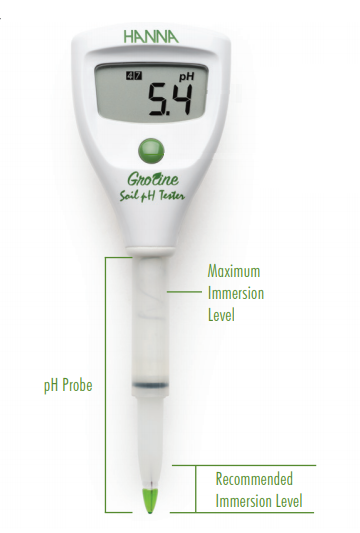How to Measure Soil pH using the IC-HI981030 Groline Soil pH Tester

The IC-HI981030 is a pocket-sized, application-specific soil pH tester packed with features to help you streamline the collection of soil pH information. The advanced features of this pH tester enable you to take accurate measurements time and time again.
The cutting-edge features of the Groline soil pH tester include:
- Conical electrode tip for easy soil penetration
- Open junction electrode with a removable sleeve; and
- On-screen stability indicator.
Figure 1 Watch an Instrument Choice Scientist demonstrate how to take a soil pH measurement here.
How to Measure Soil pH using the IC-HI981030 Groline Soil pH Tester
Tools Required
- Tap water for rinsing
- Distilled water to soften the soil
- The IC-HI981030 meter with the cap removed
- An Instrument to dig with (Auger, ruler, etc.)
Measurement Note 1: Before each use, inspect the pH probe to ensure the bridge electrolyte has not dried out and calibration has completed. If the electrolyte is dehydrated or you are not sure how to complete a calibration, click here to learn how.
Measurement Note 2: When digging holes for measurement, ensure they are the same depth each time. This consistency will help to avoid discrepancies in your pH data.
Method
- Using a digging instrument, dig a small hole to loosen the soil where you wish to obtain a pH measurement.
- Add some distilled water to the hole. The soil in the hole should be damp, but not saturated.
- Rinse the electrode in the tap water and then insert it in the hole, observing the minimum and maximum penetration depth.

Figure 1: Minimum and maximum penetration depth on the IC-HI981030 GroLine Soil pH Tester. - Allow the reading to develop and stabilise. When the small hourglass disappears from the screen, the measurement is stable.
- Once the hourglass disappears, observe the final soil pH reading.
- Remove from the soil and rinse. Repeat the same to take further measurements.
- After use and before storage, clean the electrode thoroughly in distilled or deionised water. Then add a few drops of the included electrolyte storage solution to the cap and store away for your next soil pH measurement.
Conclusion
The IC-HI981030 is an application-specific soil pH tester with cutting-edge features that simplify the taking of soil pH measurements. The impressive range of functions ensures fast and accurate soil pH measurements every time.
If you would like more information on the IC-HI981030 soil pH tester, see the additional links (below) or contact us!
Additional links
- View the GroLine Soil pH Tester - IC-HI981030 here.
- Watch 'How to Measure Soil pH using the IC-HI981030 Groline Soil pH Tester' again.
- Need to calibrate? Watch an Instrument Choice Scientist Demonstrate 'How to Calibrate the IC-HI981030 GroLine Soil pH Tester.'
- Want to see want comes with the IC-HI981030 kit? Watch an Instrument Choice Scientist Unboxing the IC-HI981030 GroLine Soil pH Tester
- Learn all the definitions that come with a soil pH Tester in the article 'Soil pH Testers; How to read specifications'
Also interesting
Harmful bacteria thrive in environments where pH is close to neutral or 7. It’s most practical, economical and legal to keep the pH of meat should low during the entire production process. You will prevent spoilage, maintain quality and comply with food safety regulations.
The IC-HI981036 meat pH meter by Hanna Instruments is designed especially for meat processing. Instrument Choice is impressed with the device’s practical design. For example, the meter features a conical tip that aids in penetrating meat when you are taking measurements. We also like the removable electrode sleeve that prevents blockages in the sensor mechanism and assists thoroughly clean the instrument.

The determination of moisture content within honey is key to assessing the quality of this product. The moisture present within honey determines its stability. Honey high in moisture is prone to fermentation and granulation. The Atago IC-PAL-22s Honey Moisture Refractometer will determine the moisture content of honey at the touch of a button.

